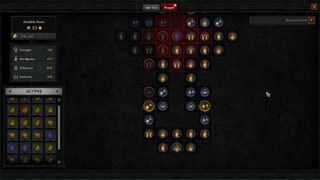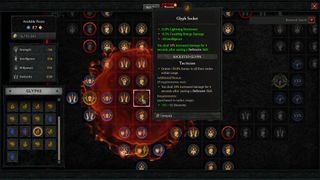
The Diablo 4 Paragon Board is a part of the action-RPG that you'll need to quickly wrap your head around, particularly if you are trying to maximise your endgame progression opportunities. This system will guide you through the challenges once you hit level 50, and you'll need to make smart use of Paragon Points in Diablo 4 if you want any chance of surviving the tougher world tiers.
Admittedly, the Paragon Board and Paragon Points system is quite complicated to wrap your head around though, especially if you didn't play Diablo 3. So here I'm going to walk you through how the Paragon Board works in Diablo 4, how to get the most out of the skill trees, and how you can use Glyphs and Gates to make your class truly unstoppable.
Diablo 4 Paragon Board explained

The Paragon Board is what you'll use to progress towards the Diablo 4 Max Level cap of 100. If you're wondering how to unlock the Paragon Board in Diablo 4 don't worry – it'll become available for your character automatically, once you hit level 50, Basically, the Paragon Board is designed to gradually improve your class build's power and proficiencies – it lets you decide how you want to increase specific Skill attributes (Dexterity, Intelligence, Strength, and Willpower) and provides passive bonuses along the way. The Board itself is class specific – it's different for Barbarians, Druids, Necromancers, Rogues, and Sorcerers but the principals of how it works remain the same for each.
How to earn Diablo 4 Paragon points

Once you hit level 50, you'll stop earning regular Skill Points. Instead, any XP that you earn by completing Nightmare Dungeons, killing enemies, and completing activities like Diablo 4 Helltide events and Tree of Whispers contracts goes towards earning Paragon Points. You gain one Paragon Point for each quarter of a level you gain – look at your XP ba and you’ll see it’s not got little pips on it – meaning that you can earn four Paragon Points per level. You'll be able to spend these Paragon Points that you earn on different nodes of the board.
However, unlike Diablo 3’s Paragon system, Diablo 4 has a hard Paragon Point cap of 220. That means that once you’ve earned 220 points, you'll no longer be able to earn more – spend them wisely, although you can respec your Paragon Points if you need to! You’ll earn 200 Paragon Points by leveling up from 50 to 100, while an additional 20 Paragon Points can be earned in the Tier 5 Renown boundary – so mop up all those side quests, events, and Altars of Lilith in Diablo 4; and you'll need to unlock the Diablo 4 World Tier 3 difficulty setting too.
How to use the Paragon Board and spend Paragon Points

The Paragon Board is imposing, and getting the most out of this thing will require some careful planning. You start at the bottom of the board and work your way up to the top, investing your Paragon Points in spaces called Nodes – each Node costs just one Paragon Point and adds specific benefits that will make your build stronger and more versatile. It functions the same across all five classes but the Nodes are different for each one – for example, Sorcerers may see an increase in Intelligence, while Necromancers will have Nodes that strengthen Dexterity and Willpower.
It's worth noting that there are four types of rarity to nodes on the Parergon Board, giving you something else to think about as you choose where to put your Points.
- Common: +5 to a base stat
- Magic: Damage, defense, or utility bonus.
- Rare: Two damage, defense, utility, or stat bonus
- Legendary: Benefits change depending on your build board
As you move up the board, you'll also come across empty Glyph sockets; These allow you to add special passive effects to the board, or modify the stats of nearby Nodes. Finally, once you reach the top of the Paragon Board you'll encounter a Gate – the Gate node not only provides a +5 bonus to all stats, but it also enables you to connect an additional Paragon Board onto the one you're currently working through, allowing you to become more powerful and further specialize your build.
How to get Glyphs and use Paragon Board Glyph sockets

As you move through your various Paragon Boards you'll notice empty Glyph sockets. You can insert your collected Glyphs and they’ll apply either a passive benefit or modify the statistics of nearby nodes within a three-square radius. Glyphs can be earned by killing monsters across the Diablo 4 map and can be upgraded too. For more information on the rather confusing system, you'll want to check out our full Diablo 4 Glyphs guide.
Attaching new Paragon Boards

Alright, we're almost there… I promise. At the end of every Paragon Board in Diablo 4 is a Gate. This unique Node will let you connect multiple board pieces, and these additional boards are designed to further hone in on specific builds. For example, with my best Diablo 4 Necromancer build, I decided to prioritize strengthening my Army of the Dead, and once I'm done with that board I'll likely look to improve the viability of my Curse magic like Exploding Corpses.
Each class has access to eight unique boards, with every one of them equipped with a special Legendary node socket and a Glyph socket. While you can not reuse the same Paragon Board twice, you are able to rotate them, allowing you easier access to the stat bonuses and node sockets you want to prioritize.
How to respec Paragon Boards

You can respec a Paragon Board with Gold, but this starts to become very expensive the closer you creep to Level 100. It's worth taking the time to plan your route ahead before investing Paragon Points. However, if a Paragon Board has no Points allocated towards it – all the Nodes are empty – you are able to remove the board entirely and swap it out for one of the others at no cost.
Sign up to the GamesRadar+ Newsletter
Weekly digests, tales from the communities you love, and more

Josh West is the Editor-in-Chief of GamesRadar+. He has over 15 years experience in online and print journalism, and holds a BA (Hons) in Journalism and Feature Writing. Prior to starting his current position, Josh has served as GR+'s Features Editor and Deputy Editor of games™ magazine, and has freelanced for numerous publications including 3D Artist, Edge magazine, iCreate, Metal Hammer, Play, Retro Gamer, and SFX. Additionally, he has appeared on the BBC and ITV to provide expert comment, written for Scholastic books, edited a book for Hachette, and worked as the Assistant Producer of the Future Games Show. In his spare time, Josh likes to play bass guitar and video games. Years ago, he was in a few movies and TV shows that you've definitely seen but will never be able to spot him in.

This Steam Next Fest action-RPG is a delightful throwback to '90s anime and SNES classics, even if it is also marketing for a much bigger and hornier deckbuilder JRPG

Black Myth: Wukong just got an Xbox ESRB rating alongside confirmation that a PS5 physical release is imminent, meaning I can finally see what all the hype is about